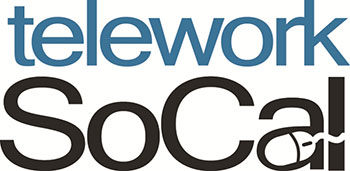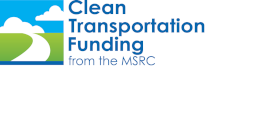 Telework, also known as telecommuting, has been around for decades, but has really gained ground in the last few years with advancements in communications technology. The MSRC is funding the Telework SoCal program to examine perceived barriers to telework and overcome these barriers by implementing successful telework programs at businesses and organizations throughout the South Coast region.
Telework, also known as telecommuting, has been around for decades, but has really gained ground in the last few years with advancements in communications technology. The MSRC is funding the Telework SoCal program to examine perceived barriers to telework and overcome these barriers by implementing successful telework programs at businesses and organizations throughout the South Coast region.
“Tele” means “at a distance,” and this is exactly what telework allows employees to do – work at a distance from their traditional office environment, either at home or another worksite geographically convenient to their home, on either a full- or part-time basis. It offers an exciting opportunity for both employers and employees because it can save businesses money and increase their employees’ productivity, while allowing employees to get more of their work done and have a better work-life balance. Telework benefits the environment as well by taking cars off the road as traditional commuting is reduced.
The Telework SoCal program is a free, one-stop information and assistance resource for employers interested in implementing telework programs in Los Angeles, Orange, Riverside and San Bernardino Counties. The program will select up to 15 local businesses and organizations of varying sizes and industries to participate through a competitive application process. Applications are due by April 30 and can be found on the Telework SoCal website (http://teleworksocal.com/), and for more information please call 310-474-2325.
Elham Shirazi, who is heading the Telework SoCal team, believes telework is particularly beneficial to employers especially in today’s economy. “The number one reason employers are looking to have telework at their companies is that it allows them to evaluate their infrastructure to determine whether they need such a large workplace.” According to Elham, about 30 percent of office space is underutilized because employees travel, meet with clients off-site, or are on vacation. “Telework allows companies to hold on to their talent but cut back on unnecessary real estate and parking expenses, plus it saves energy by allowing lights and computers to be turned off in unoccupied offices, saving employers even more money.”
Telework also helps employers grow their bottom line by increasing their employees’ productivity. Employees have more time to perform their duties because they are not stuck in traffic trying to get to the office, and are more productive because they can work without typical office distractions. “The return on investment for employers is very high. Worker productivity goes up between 10 to 20 percent because of the lack of disruptions when people work remotely,” Elham said.
Moreover, telework is an attractive work option for some employees. This increases the rates of employee recruitment and retention, further enhancing an employer’s investment because they do not have to spend money recruiting and training new employees. “The core of people and talent is becoming more important in today’s economy as companies shrink, so keeping your employees is an added benefit of telework,” she noted.
Employees like telework because it gives them a better work-life balance. They save hours in commuting time, giving them more time to spend with their families and more flexibility to schedule personal appointments, and also save money on commuting costs. This helps improve morale, enhancing an employee’s desire to stay with their current company, and reducing employee turnover by up to 65 percent, according to Elham.
The Telework SoCal team includes seven firms that specialize in everything from research to technology to program development and implementation. “This is a multi-layered project with many phases to it, so we have assembled a team of experts to conduct research, develop our website, recruit employers, implement company-specific telework programs for each participating employer, evaluate the program, and finally, train the staff of the county transportation commissions (Metro, OCTA, RCTC, and SANBAG) to maintain these programs should they decide to continue them.”
The research phase of the project looked at national trends for telework programs in order to provide guidance for the MSRC-funded program. Last year, 83 of the Fortune® 100 Companies offered telework. Eighty-seven percent of firms nationwide have some sort of informal telework, like as allowing an employee to work from home every once in a while or because of a family emergency. The Telework SoCal team also interviewed 20 different employers across the four-county region, and found that eighty percent of the companies interviewed have at least informally considered telework.
Part of the research phase included exploring the perceived obstacles to telework. The top two barriers to implementing a telework program are lack of management support and the lack of work/jobs conducive to teleworking. “Getting middle managers to support a telework program can be challenging because they are worried about losing control – they think ‘how can I manage someone I can’t see,’” Elham explained.
The Telework SoCal program is designed to overcome these perceived obstacles and implement telework at companies that currently have no formal telework programs. “Our first step is to train middle managers at the outset. There needs to be a commitment from upper management and buy-off at the middle management level. If managers feel they are losing control of their employees, then the program won’t be successful,” Elham said. Telework SoCal will help companies develop parameters about what telework is and what it is not, and offers a template of polices and rules that employers can tailor to their own needs so that both the employer and employee understand the objectives and the deliverables of the program.
The MSRC first explored telework in the 1990s yet it never really got off the ground, not only because of the perceived barriers, but also because the technology was not available. Today, the technology is so advanced that work is now portable – smart phones, high speed internet access, programs that enable workers to remotely access their office computers, and other technologies make it the ideal time for the MSRC to re-examine this type of alternative commute option as another one of its tools to help combat harmful emissions from motor vehicles.
